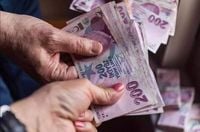On April 16, 2025, the Turkish lira is experiencing notable fluctuations against major currencies amid ongoing economic developments. According to reports from EADaily, the exchange rate for the Turkish lira to the Russian ruble stands at 2.17, a slight decrease from the previous rate of 2.18. Meanwhile, the U.S. dollar is priced at 38.1 lira, showing a rise from 38.01. The euro is trading at 43.07 lira, down from 43.19, while the British pound sterling costs 50.42 lira, up from 50.16. The Swiss franc is valued at 46.5 lira, down from 46.7, and the Chinese yuan is at 5.21 lira, a slight increase from 5.2.
In addition to the fluctuations of the Turkish lira, Goldman Sachs has issued a concerning forecast regarding the Russian ruble. The investment bank predicts that the ruble will weaken to 100 rubles per dollar by the summer of 2025. This projection is based on external sanctions against Russia and internal macroeconomic challenges. Analysts from Goldman Sachs expect the dollar to reach 120 rubles in 2026 and 130 rubles in 2027 and 2028.
Goldman Sachs' analysts indicate that the ruble could depreciate by more than 48% compared to current levels. On April 15, 2025, the dollar rate on the over-the-counter market was reported at 82.2347 rubles, a marginal increase of 0.01%. The euro was trading at 93.123 rubles, reflecting a decrease of 0.24%.
Furthermore, Goldman Sachs anticipates that the euro will strengthen by 7% annually, predicting a rate of $1.2 per euro over three years. The investment bank has labeled the Japanese yen as the "safest haven," expecting it to appreciate approximately 20% over the next three years, with predicted rates of 127 yen per dollar in 2026, 120 yen in 2027, and 115 yen in 2028.
As for the current state of the ruble, it shows mixed changes against key currencies, reflecting a recent weakening of the dollar and a rise in the euro. On April 16, 2025, at 9:30 AM Moscow time, the dollar/ruble pair was quoted at 82.10, marking a 1.7% increase from Tuesday's close. The ruble had previously weakened by 1.6% on Tuesday but reached a four-week high of 81.80 during trading.
Meanwhile, the euro/ruble pair is trading at 95.12, with the ruble losing 0.9% from Tuesday's values after a 1% depreciation against the euro the day before. The dollar index is currently down 0.6%, quoted at 99.52, close to a two-month minimum of 99.02 reached on the previous Friday. The euro has gained 0.8% against the dollar, trading at $1.1372, near its maximum since February 2022.
Analysts attribute the dollar's struggles to a loss of confidence in the U.S. economy, particularly following a series of inconsistent economic policies from the Trump administration that have led to radical trade tariffs. As a result, investors are leaning towards safer assets like gold, which has recently reached record highs, as well as the Swiss franc and the Japanese yen.
Despite the global uncertainty affecting the dollar, the ruble has largely avoided the negative impacts of high external uncertainty and risk aversion. This is partly due to the local currency market being somewhat insulated from global capital markets, given the Western sanctions and corresponding Russian capital restrictions. Support for the ruble also comes from high interest rates, with the Central Bank of Russia maintaining a rate of 21% annually, alongside reduced imports and a steady influx of export revenues.
On the morning of April 16, oil prices are also on the decline, with Brent crude losing over 1%, priced at $63.99 per barrel. Additionally, the Central Bank of Russia is selling yuan in significant volumes as part of its National Wealth Fund expenditures, conducting operations under the budget rule at approximately 10.5 billion rubles daily. This activity has recently exceeded 10% of the average daily volume of yuan/ruble exchange trades.
On April 15, the trading volume in the yuan/ruble pair on "tomorrow" settlements on the Moscow Exchange reached 93 billion rubles. The Russian currency concluded the trading session at 11.23 rubles per yuan, reflecting a loss of 0.3%. However, during trading, the ruble rose to a four-week peak of 11.10.
Geopolitical factors continue to play a role in the ruble's performance, with hopes surrounding the prospects for Russia and the potential for a ceasefire in the ongoing conflict in Ukraine. These sentiments are fueled by ongoing negotiations between Moscow and Washington at various levels.
The official exchange rates set by the Central Bank for April 16 reflect the recent strengthening of the ruble, with rates amounting to 11.16 rubles per yuan (down from 11.23), 82.30 rubles per dollar (down from 82.77), and 93.68 rubles per euro (down from 94.16). The dollar's exchange rate is now at its lowest in four weeks, while the yuan's rate is at its lowest since June of the previous year.
As the economic landscape continues to evolve, both the Turkish lira and the Russian ruble face significant challenges and opportunities influenced by global market trends and local economic policies. Investors and analysts alike will be closely monitoring these developments in the coming weeks.






